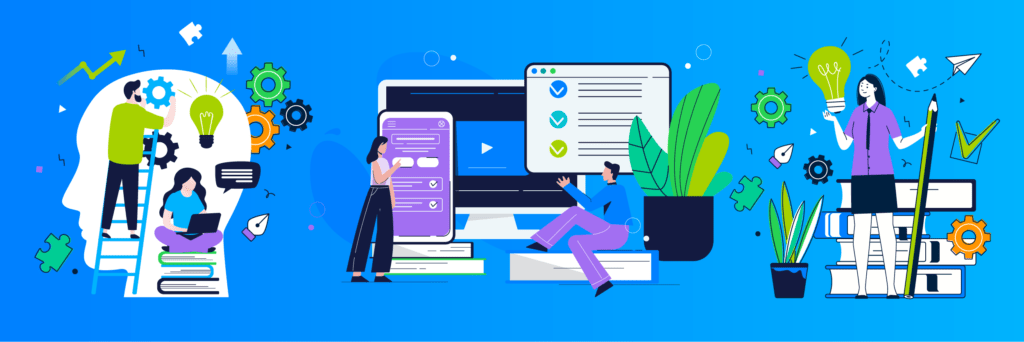The 4 Parts of Highly-Effective Employee Learning and Development

There are so many variables to consider when designing your employee learning and development (L&D) strategy. And, there are just as many variables on how to set up your digital employee training solution to support that strategy. Here are four distinct parts that must be included in your L&D strategy, and the solution that supports it, that’ll set your strategy on a trajectory to success.
Part 1: Establish Your Metrics
The best way to get where you’re going is to set a destination and then map out how to get there. The same holds true for your L&D strategy. What goals and objectives are you looking to accomplish? What business results do you want to achieve?
First and foremost, your eLearning success metrics need to include engagement. Because if employees aren’t using your training, you’ll never reach your objective. Then, go one step further by measuring what content gets used the most, how long it takes employees to complete training, and which groups use what content. You can even measure revenue per employee, retention, and attendance to see how well your team is operating, and link that to training efficacy.
Part 2: Focus on Content
Where the mantra in real estate is location, location, location—the mantra that exemplifies the importance of employee L&D is: content, content, content. And you can’t create content in a vacuum if you want your strategy to be effective. You’ve got to go to subject matter experts or business units where the operational information and knowledge lie.
Make it easy to capture that knowledge by using collaborative content authoring tools that don’t require coding expertise. You set up templates and branding, the SMEs supply the content. This will enable you to reduce content development time by up to 60% while reducing training costs. And, when changes happen (and they will), you can edit and distribute new content even faster. Notifications allow employees to see right away what’s been updated.
All of this mission-critical content is housed in a single source of truth via a knowledge and training platform that anyone, anywhere, on any device can access. That means if you’ve had trouble before delivering shoulder-to-shoulder training, on the job—your problem is solved.
Part 3: Don’t Try to Boil the Ocean
Start with your most critical areas of need first, and be ready to expand and iterate. Many times this is in the operational areas of your business, which is why your digital employee training solution needs to be agile, unlike a traditional LMS. Operations need to shift on a dime to respond to disruption and changing market conditions, and operational training needs to do the same.
Once you get operational training down in one area, you can move that on to other areas. We’ve seen large, distributed operations not only adapt faster when it’s required (up to 60% faster) but also maintain standards and brand consistency with better training and knowledge. It pays to get it right first then build from there.
Part 4: Create a Feedback Loop
Like we said before, your employee learning and development strategy is only as good as the content, and how much that content gets used by employees. The best way to ensure that your content will be effective is to create a feedback loop.
Ask employees if they believe they are getting value out of the content. Do they feel that it increases their skill set and furthers their careers? Do managers believe the content makes their employees more effective at their jobs? If not, why not? Also find out if there’s a lack of the right content, too much of the wrong content, or both. This can all be done within your digital employee training solution.
Traditional learning management systems are powerful and useful but often can’t meet the unique needs of decentralized, frontline workers. To discover what solution might be the best fit for your needs try our interactive solutions guide.
